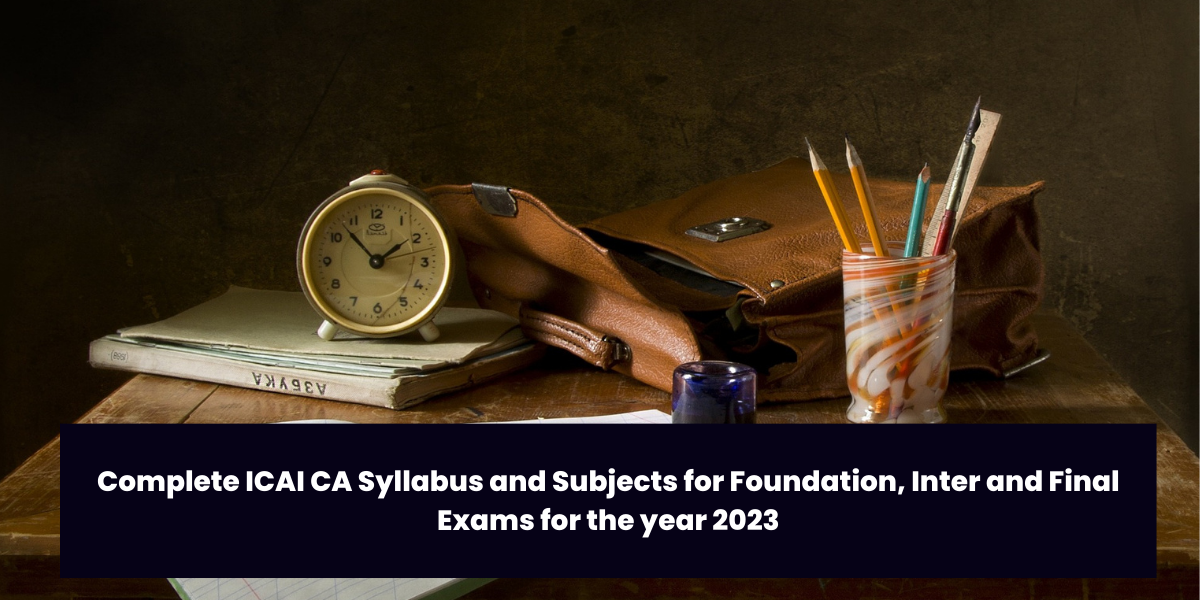Candidates preparing for the highly competitive CA examinations should be well aware of the CA syllabus beforehand. The Institute of Chartered Accountants of India (ICAI) conducts the CA exams every year. The university grants commission(UGC), which is a statutory body by the Government of India has declared the CA course as similar to that of a postgraduate degree.
Here is a detailed CA syllabus by Vsmart Academy for the aspirants so that they can have an adequate knowledge of subjects in the CA syllabus, before the commencement of classes.
CA Course Highlights:
| Course Name | Chartered Accountant |
| Course structure |
|
| Course type | Certificate course |
| Course duration | 5 years |
| Total number of Papers |
|
Minimum Eligibility criteria to apply for CA examinations:
- It is mandatory for all candidates to have passed the 10th and 10+2 from any recognised board.
- Candidates in commerce field must have at least 55% and in case of belonging to any other stream, a minimum of 60% is required.
- There is no age limit as such to appear for the CA exams.
CA Foundation Subjects:
CA foundation is the stepping stone for an aspiring chartered accountant. The candidate must know of the horizon he/she is stepping towards.
CA Foundation subjects for the exams include:
| Subjects | Total Marks |
| Principles and practices of accounting | 100 |
Business Law & Business Correspondence and Reporting
|
100 |
Business Mathematics and Logical Reasoning & Statistics
|
100 |
| Business Economics & Business and Commercial Knowledge | 100 |
CA Foundation Syllabus 2023:
A candidate must secure 40% in order to pass the CA foundation exams. The Paper 1 ( principles and practices of accounting) includes these below mentioned subjects:
1.Theoretical Framework
2.Accounting Process
3.Preparation of Trial Balance
4.Rectification of Errors etc,
5.Bank Reconciliation Statements
6.Inventories
7.Concepts and Accounting for Depreciation
8.Accounting for Special Transactions
9.Final Accounts of Sole Proprietors
10.Partnership Accounts
11.Financial Statements of Not-For Profit Organizations.
12.Introduction to the Company Accounts
13.Basic Accounting Ratios.
Paper 2 (business law & business correspondence and reporting)
This paper is divided into two parts, carrying 60 marks and 40 marks respectively.
| PART 1 | Communication |
| PART 2 |
|
| PART 3 |
|
| PART 4 | Developing writing skills:
|
Paper 3 – Business Mathematics and Logical Reasoning and Statistics:
The third paper mainly tests the logical intelligence of every candidate. It has again been divided into three parts:
| Section A | Section B | Section C |
| Ratio and Proportion, Indices and Logarithms | Number series, Coding and Decoding and odd man out. | Statistical description of Data |
| Equations and Matrices | Direction Tests | Measures of Central tendency and Dispersion |
| Linear Inequalities with Objective Functions and Optimization w.r.t. objective function. | Seating Arrangements | Probability |
| Time value of Money | Blood Relations | Theoretical Distributions |
| Permutations and Combinations | Syllogism | Correlation and Regression |
| Sequence and Series | Index Numbers and Time Series | |
| Sets, Relations, and Functions | ||
| Basic applications of Differential and Integral calculus |
Paper 4 – Business Economics & Business and Commercial Knowledge
The paper 4 has again been divided into two parts, namely section A and Section B:
| Section A | Section B |
| Introduction to Business Economics | Business and Commercial Knowledge – An Introduction |
| Theory of Demand and Supply | Business Environment |
| Theory of Production and Cost | Business Organizations |
| Price Determination in Different Markets | Government Policies for Business Growth |
| Business Cycles | Organizations Facilitating Business |
| Common Business Terminologies |
The CA Intermediate Subjects:
The CA Intermediate exam is the second level to crack the CA exams. It carries 8 subjects and is divided into two groups with each containing four subjects. In order to reach the final level, it is necessary for the aspirants to clear the intermediate level. The candidate is provided with a duration of 8 months to complete these subjects. The CA Inter subjects are:
| PAPERS | SUBJECTS | TOTAL MARKS |
| PAPER 1 | Accounting | 100 marks |
| PAPER 2 | Corporate laws and other laws | 100 marks |
| PAPER 3 | Cost and management accounting | 100 marks |
| PAPER 4 | taxation | 100 marks |
| PAPER 5 | Advanced accounting | 100 marks |
| PAPER 6 | Auditing and assurance | 100 marks |
| PAPER 7 | Enterprise information system and strategic management | 100 marks |
| PAPER 8 | Financial management and economics for finance | 100 marks |
The CA Intermediate Syllabus:
After getting the overview about the CA Inter Subjects it’s time to get a detailed knowledge regarding the syllabus. Here is a detailed CA syllabus for better understanding of CA Inter subjects :
Paper 1 – Accounting:
| SL. NO | TOPIC |
| 1. | Process of formulation of Accounting Standards including Ind ASs (IFRS converged standards) and IFRSs; convergence vs adoption; objective and concepts of carve outs |
| 2. | Framework for Preparation and Presentation of Financial Statements (as per Accounting Standards) |
| 3. | Application of Accounting Standards |
| 4. | Company Accounts |
| 5. | Accounting for Special Transactions |
| 6. | Special Type of Accounting |
| 7. | Dissolution of partnership firms including piecemeal distribution of assets; Amalgamation of partnership firms; Conversion of partnership firm into a company and Sale to a company; Issues related to accounting in Limited Liability Partnership. |
Paper 2 – Corporate and Other Laws :
| SECTION A | SECTION B |
| Preliminary | The Indian Contract Act, 1872 |
| Incorporation of Company and Matters Incidental thereto | The Negotiable Instruments Act, 1881 |
| Prospectus and Allotment of Securities | The General Clauses Act, 1897 |
| Share Capital and Debentures | Interpretation of Statutes. |
| Acceptance of Deposits by companies | |
| Registration of Charges | |
| Management and Administration | |
| Declaration and Payment of Dividend | |
| Accounts of Companies | |
| Audit and Auditors |
Paper 3- Cost and management accounting :
| SL. NO. | TOPICS |
| 1. | Overview of Cost and Management Accounting: Introduction to Cost and Management Accounting. Elements of cost and preparation of cost sheets. |
| 2. | Ascertainment of Cost and Cost Accounting System:
|
| 3. | Methods of Costing :
|
| 4. | Cost Control and Analysis:
|
Paper 4- Taxation
| SECTION A | SECTION B |
| Basic concepts | Concept of indirect taxes |
| Residential status and scope of total income | Concept and features of indirect taxes |
| Income which do not form part of the total income | Principal indirect taxes |
| Heads of Income and computation of Income | Goods and Services Tax (GST) Laws |
| Income of other person’s included in assessee’s total income | GST Laws: An introduction including Constitutional aspects |
| Aggregation of Income, Set off or Carry forward and set off of losses. | Levy and collection of CGST and IGST |
| Deduction from the Gross Total Income | Application of CGST / IGST law |
| Deduction from the Gross Total Income | Concept of supply including composite and mixed supplies |
| Advance Tax, Tax deduction at source and Introduction to Tax Collection at Source | Charge of tax |
| Provisions for filing return of Income and Self Assessment | Exemption from tax |
| Composition levy
|
This paper also includes:
- The Basic concepts of time and value of supply:
- Input tax credit
- Computation of GST liability
- Registration
- Tax invoice; Credit and Debit Notes; Electronic way bill
- Returns
Paper 5- Advanced accounting:
| SL.NO. | TOPICS |
| 1. | Application of Accounting Standards. |
| 2. | Application of Guidance Notes issued by the ICAI on specific accounting aspects. |
| 3. | Special aspects of Company Accounts. |
| 4. | Reorganization of Companies. |
| 5. | Financial Reporting of Banking, Financial Services and Insurance |
| 6. | Valuation of Goodwill. |
| 7. | Consolidated Financial Statements. |
Paper 6 – Auditing and Assurance:
| SL.NO. | TOPICS |
| 1. | Nature, Objective, and Scope of Audit.
|
| 2. | Audit Strategy, Audit Planning, and Audit Programme. |
| 3. | Audit Documentation and Audit Evidence |
| 4. | Risk Assessment and Internal Control.
|
| 5. | Fraud and Responsibilities of an Auditor in this regard. |
| 6. | Audit in an Automated Environment. |
| 7. | Audit Sampling. |
| 8. | Analytical Procedures. |
| 9. | Audit of Items of Financial Statements. |
| 10. | The Company Audit |
| 11. | Audit Report |
| 12. | Audit of Banks |
| 13. | Audit of Different types of Entities.
|
Paper 7 – Enterprise Information Systems and Strategic Management:
| SECTION A | SECTION B |
| Automated Business Processes | Introduction to Strategic Management. |
| Financial and Accounting Systems. | Strategic Management Process |
| Information Systems and its Components. | Dynamics of Competitive Strategy. |
| E-Commerce, M-Commerce and Emerging Technologies. | Strategic Management Process. |
| Core Banking Systems. | Corporate level strategies. |
| Organization and Strategic Leadership | |
| Strategy Implementation and Control. |
Paper 8 – Financial Management and Economics for Finance
| SECTION A | SECTION B |
Financial Management and Financial Analysis:
|
Determination of National Income |
Financing Decisions:
|
Public Finance |
Capital Investment and Dividend Decisions:
|
The Money Market |
| Management of Working Capital | The International trade |
The whole CA intermediate exam has a total of 800 marks. When compared to the CA foundation exams, the intermediate level is one scale higher in the difficulty range.
CA FINAL Subjects:
Students can appear for the final CA exams only after completing 2.5 years of articleship in the final level. The exams are conducted twice a year. CA final syllabus is divided into two groups, comprising eight papers each. The CA Final Subjects are as follows
| Total number of Papers | CA Final Subjects | Total Marks |
| Paper 1 | Financial Reporting | 100 |
| Paper 2 | Strategic Financial Management | 100 |
| Paper 3 | Advanced Auditing and Professional Ethics | 100 |
| Paper 4 | Corporate Laws and other Economic Laws | 100 |
| Paper 5 | Strategic Cost Management and Performance Evaluation | 100 |
| Paper 6 | Elective Paper | 100 |
| Paper 7 | Direct Tax Laws | 100 |
| Paper 8 | Indirect Tax Laws | 100 |
CA Final Syllabus:
| PAPER 1 | PAPER 2 |
| Application of Guidance Notes issued by the ICAI on Specified Accounting Aspects. | Financial Policy and Corporate Strategy. |
| Framework for the preparation and presentation of Financial Statements | Indian Financial System. |
| Application of Indian Accounting Standards (IND AS). | Risk Management. |
| Consolidated and Separate Financial Statements (as per IND AS) | Security Analysis. |
| Application of Industry-specific and Transaction-specific Indian Accounting Standards. | Security Valuation |
| Business Combinations and Accounting for Corporate Restructuring/ Demerger | Portfolio Management. |
| Accounting and Reporting of Financial Instruments (As per IND AS). | Securitization |
| Accounting for Share-Based Payments | Mutual Funds |
| Analysis of Financial Statements. | Derivatives Analysis and Valuation |
| Accounting for Carbon Credits | Foreign Exchange Exposure and Risk Management. |
| Accounting for E-Commerce | International Financial Management |
| Emerging trends in Reporting. | Interest Rate Risk Management |
| Corporate Valuation | |
| Mergers, Acquisition and Corporate Restructuring. | |
| International Financial Center (IFC). | |
| Startup Finance | |
| Small and Medium Enterprises |
Paper 3: Advanced Auditing and Professional Ethics:
| SL.NO. | TOPICS |
| 1. | Auditing Standards, Statements and Guidance Notes |
| 2. | Audit Planning, Strategy and Execution. |
| 3. | Risk Assessment and Internal Control |
| 4. | Special Aspects of Auditing in an Automated Environment. |
| 5. | Audit of Limited Companies. |
| 6. | Audit Reports. |
| 7. | Audit Reports and Certificates for Special Purpose Engagements. |
| 8. | Audit Committee and Corporate Governance. |
| 9. | Audit of Consolidated Financial Statements. |
| 10. | Special Features of audit of Banks, Insurance and Non Banking Financial Companies. |
| 11. | Audit under Fiscal Laws. |
| 12. | Special Audit Assignments. |
| 13. | Audit of Public Sector Undertakings. |
| 14. | Liabilities of Auditors. |
| 15. | Internal Audit, Management and Operational Audit. |
| 16. | Due Diligence, Investigation and Forensic Audit. |
| 17. | Peer Review and Quality Review. |
| 18. | Professional Ethics. |
Paper 4: Corporate and Economic Laws
SECTION – A
This paper aims at testing the candidate’s ability to apply laws in practical situations.
- Includes Appointment and Qualification of Directors.
- Appointment and Remuneration of Managerial Personnel.
- Meetings of Board and its Powers.
- Inspection, Inquiry and Investigation.
- Compromises, Amalgamations and Arrangements.
- Prevention of Oppression and Mismanagement.
- Winding Up.
- Producer Companies.
- Companies incorporated outside India.
- Miscellaneous Provisions.
- Compounding of Offenses, Adjudication and Special Courts.
- National Company Law Tribunal and Appellate Tribunal.
SECTION – B :
1.The Securities Contract (Regulation) Act, 1956 and Securities Contract (Regulation) Rules, 1957. Introduction and Important Provisions.
2.The Securities Exchange Board of India Act, 1992, SEBI (Issue of Capital and Disclosure Requirements) regulations, 2009 and SEBI(Listing Obligation and Disclosure Requirements) Regulations, 2015.
PART – 2 ECONOMIC LAWS
Concerned topics:
- The Foreign Exchange Management Act, 1999.
- The Securitisation and Reconstruction of Financial Assets and Enforcement of Security Interest Act, 2002.
- The Prevention of Money Laundering Act, 2002.
- Foreign Contribution Regulation Act, 2010.
- The Arbitration and Conciliation Act, 1996.
- The Insolvency and Bankruptcy Code, 2016.
Paper 5: Strategic Cost Management and Performance Evaluation
- Strategic Cost Management and Decision Making.
1.Strategic Cost Management
2.Strategic Decision Making
- Performance Evaluation and Control.
Performance Evaluation and Reporting. - Managerial Control.
- Case Studies (Covering course Concepts)
PART – 1 STRATEGIC COST MANAGEMENT AND DECISION MAKING
SECTION – A Introduction to Strategic Cost Management.
- Modern Business Environment.
- Learn System and Innovation.
- Cost Management Techniques.
- Cost Management for Specific Sectors.
SECTION – B
- Decision Making
- Pricing Strategies / Decisions
PART – 2
SECTION – A
- Performance Measurement and Evaluation
- Divisional Transfer Pricing
- Strategic Analysis of Operating Income.
SECTION – B
- Budgetary Control
- Standard Costing
SECTION – C
This section covers basic course concepts.
Paper 6: Elective Paper
Candidates are welcome to select any desired elective in this paper.
- 6A Risk Management,
- 6B Financial Services, and Capital Markets,
- 6C International Taxation,
- 6D Economic Laws,
- 6E Global Financial Reporting Standards,
- 6F Multi-disciplinary Case Study
PAPER – 6A RISK MANAGEMENT
Businesses face a lot of risks in their long run. This particular section helps the candidates to learn various techniques to handle such risky situations or avoid them altogether. The covered topics in this paper are:
- Introduction to Risk
- Source and Evaluation of Risks.
- Risk Management.
- Quantitative Analysis
- Risk Model
- Credit Risk Measurement and Management.
- Risk Associated with Corporate Governance.
- Enterprise Risk Management.
- Operational Risk Management.
PAPER – 6B:
- Global Financial Markets
- Impact of Various policies of Financial Markets
- Capital Market – Primary
- Capital Market – Secondary
- Money Market
- Institutions and Intermediaries
- Commodity Market
- A. Banking Management
- Banking as a source of capital including NBFCs
- Mutual Funds
- Private Equity
- Investment Banking
- Credit Rating
- Treasury Operations
- Risk Management
- Credit Derivatives
- SEBI Guidelines
Topics covered in SFM and law:
- Securitization
- Fixed Income Securities (Valuation of Bonds/ Debentures)
- Derivatives
- Interest Rate Risk
- The Securities and Exchange Board of India Act, 1992
- Legislative framework on listing agreements
- The Securities Contract (Regulation) Act, 1956
- Chapter III-D of the RBI Act, 1934
PAPER – 6C INTERNATIONAL TAXATION:
Two divide sections:
- Taxation of International Transactions and Non- Resident Taxation in India
- Other aspects of International Taxation
SECTION – A :
Transfer Pricing Provisions under the INCOME TAX Act, 1961.
- Arm’s Length Price
- International Transactions
Most Appropriate Method
- Functions, Assets and Risk Analysis
- Documentation & Compliances
- Specific Reporting Regime in respect of Country by Country reporting and master file
Advance Pricing Agreements
- Other Provisions relating to taxation of international transactions and non-resident taxation under the Income-tax Act, 1961
- Non-resident Taxation (including Source Rule of Taxation)
- Double Taxation Relief
Advance Rulings:
- Law and Procedures under the Black Money (Undisclosed Foreign Income and Assets) and Imposition of Tax Act, 2015 – An Overview.
SECTION – B
Covered topics:
Overview of Model Tax Conventions.
- OECD Model Tax Convention
- UN Model Tax Convention
US Model Tax Convention
- Tax treaties, Application, and Interpretation
- Features of Tax treaties
- Overview of Tax Information Exchange Agreements
Commentaries and their importance:
- Role of Vienna Convention in application and interpretation of tax treaties
- Anti Avoidance Measures
- Controlled Foreign Corporations
- Base Erosion and Profit Shifting
Other Anti Avoidance Measures:
- Taxation of E-Commerce Transactions
- Introduction
- Emerging issues
- Equalization levy:
PAPER – 6D :
World Trade Organization (WTO) covering its Role, Principles, Functions and Dispute Settlement Mechanism
- Competition Act, 2002 and Rules/ Regulations
- Real Estate (Regulation and Development) Act, 2016 [Central Act and Rules/ Regulations]
- Insolvency and Bankruptcy Code, 2016 and Rules/ Regulations
- Prevention of Money Laundering Act, 2002 and Rules/ Regulations
- Foreign Exchange Management Act, 1999 and Rules/ Regulations
- Prohibition of Benami Property Transactions Act, 1988 and Rules/ Regulations
PAPER – 6E Conceptual Framework for Financial Reporting as per IFRS – 10 Marks
- Application of International Financial Reporting Standards – 70 Marks
- Significant differences between IFRS and US GAAPs – 20 Marks
PAPER – 6F
- Financial Accounting and Reporting
- Audit and Assurance
- Taxation
- Finance and Financial Management
- Management Accounting
- Corporate Laws
- Business Strategy and Management
Paper 7: Direct Tax Laws & International Taxation:
SECTION – A:
- Special provisions relating to companies and certain persons other than a company
- Provisions relating to charitable and religious trusts and institutions, political parties and electoral trusts
- Tax Planning, Tax Avoidance & Tax Evasion
- Collection & Recovery of Tax, Refunds
- Income-tax Authorities, Procedure for assessment, Appeals and Revision
- Settlement of Tax Cases, Penalties, Offenses & Prosecution
- Liability in Special Cases
- Miscellaneous Provisions and Other Provisions
SECTION – B
- The provisions under the Income-tax Act, 1961, including
- Specific provisions relating to Non-residents
- Double Taxation Relief
- Transfer Pricing & Other Anti-Avoidance Measures
- Advance Rulings
- Equalization levy
- Overview of Model Tax Conventions – OECD & UN
- Application and interpretation of Tax Treaties
- Fundamentals of Base Erosion and Profit Shifting
Paper 8: Indirect Tax Laws:
- Goods and Services Tax (GST) Law as contained in the Central Goods and Services Tax (CGST) Act, 2017 and Integrated Goods and Services Tax (IGST) Act, 2017
- Constitutional aspects
- Levy and collection of CGST and IGST – Application of CGST/IGST law; Concept of supply including composite and mixed supplies, inter-State supply, intra-State supply, supplies in territorial waters; Charge of tax; Exemption from tax; Composition levy
Place of supply
- Time and Value of supply
- Input tax credit
- Computation of GST liability
vii. Procedures under GST – All procedures including registration, tax invoice, credit and debit notes, electronic way bill, accounts and records, returns, payment of tax including reverse charge, refund, job work
- Provisions relating to electronic commerce:
- Liability to pay in certain cases
- Administration of GST; Assessment and Audit
- Inspection, Search, Seizure and Arrest
- Demand and Recovery
- Offenses and Penalties
- Advance Ruling
- Appeals and Revision
- Other provisions
Section B:
- Customs Law as contained in the Customs Act, 1962 and the Customs Tariff Act, 1975
- Introduction to customs law including Constitutional aspects
- Levy of and exemptions from customs duties – All provisions including the application of customs law, taxable
the event, a charge of customs duty, exceptions to levy of customs duty, exemption from custom duty
- Types of customs duties:
- Classification and valuation of imported and export goods
- Officers of Customs; Appointment of customs ports, airports etc.
- Import and Export Procedures – All import and export procedures including special procedures relating to baggage, goods imported or exported by post, stores
- Provisions relating to coastal goods and vessels carrying coastal goods
- Warehousing
- Drawback
- Demand and Recovery; Refund
- Provisions relating to prohibited goods, notified goods, specified goods, illegal importation/exportation of goods
- Searches, seizure and arrest; Offenses; Penalties; Confiscation and Prosecution
- Appeals and Revision; Advance Rulings; Settlement Commission
- Other provisions
- Foreign Trade Policy to the extent relevant to the indirect tax laws
- Introduction to FTP – legislation governing FTP, salient features of an FTP, administration of FTP.
FTP and other related provisions:
- Basic concepts relating to import and export of goods
- Basic concepts relating to export promotion schemes provided under FTP
CONCLUSION:
When it comes to cracking all the three levels of CA, it has been marked and noted that a lot of students give up mid way. Chartered accountants are well paid and this is an extremely prestigious course. If given proper guidance along with hard work, sky’s the limit and anyone can break through this rigid exam. So, never give up and hang in there until you achieve success!
levels: Foundation , intermediate and Final level
CA Foundation syllabus includes Principles and Practice of Accounting, Business Laws & Correspondence and Reporting, Mathematics, Logical Reasoning and Statistics and Business Economics and Commercial Knowledge.
The CA syllabus for the ICAI Intermediate level consists of Accounting, Business Laws, Ethics and Communication, Cost Accounting and Financial Management, Taxation, Advanced Accounting, Auditing and Assurance, Information Technology and Strategic Management and Financial Management, and Economics for Finance.
The ICAI CA syllabus for the Final level consists of Financial Reporting, Strategic Financial Management, Advanced Auditing, and Professional Ethics, Corporate and Economic Laws, Strategic Cost Management and Performance Evaluation, Risk Management, Financial Services and Capital Markets, International Taxation, Economic Laws, Global Financial Reporting Standards, Multidisciplinary Case Study, Direct Tax Laws, and International Taxation and Indirect Tax Laws.
The CA syllabus is vast and contains many complex topics but it is not entirely impossible to crack the CA Foundation exam in 1st attempt.
The changes proposed by the ICAI in the CA Intermediate subjects are: Paper 1 and 5 are merged into one, and one paper is – Advanced Accounting. Enterprise Information Systems is removed from paper 7, and Economics for Finance is removed from paper 8.




